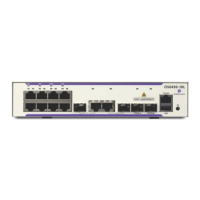page 21-18 OmniSwitch AOS Release 7 Network Configuration Guide March 2011
Congestion Avoidance
Congestion avoidance mechanisms monitor queues to provide early detection and notification of potential
queue congestion. If necessary, such mechanisms may even strategically drop low priority (non-conform-
ing) packets to prevent congestion. Dropping packets signals the packet source to decrease the transmis-
sion rate, thus preventing the queue from overflowing.
The OmniSwitch 10K uses Weighted Random Early Detection (WRED) for admission control and conges-
tion avoidance. WRED continuously monitors the average queue length over time. When the average
length exceeds specific queue thresholds, WRED begins to randomly drop packets with a specific proba-
bility.
WRED uses the drop precedence (color) of the packet to determine which packets to drop. A packet is
color marked during the QoS classification process to indicate a drop precedence for the packet.
• Green = Committed
• Yellow = Conformed
• Red = Exceeded
Color marking techniques supported include Single-Rate Tri-Color Marking (srTCM) and Two-Rate Tri-
Color Marking (trTCM). TCM is applied to ingress traffic using a QoS policy rule (see “Configuring Tri-
Color Marking” on page 21-22 for more information). Note that all packets that are not marked with a
specific color are treated as green (committed) packets.
WRED Profiles
This implementation of WRED uses drop profiles to apply active queue management to VOQs. Each
profile specifies queue thresholds (as a percentage of maximum queue size) and drop probability values
for green, yellow, and red traffic. The thresholds specify a linear relationship between average queue
length and drop probability.
A WRED drop profile (WRP) defines the following drop precedence parameters for packets marked green,
yellow, and red:
• The minimum queue length threshold (percentage of queue size).
• The maximum queue length threshold (percentage of queue size).
• The drop probability (percentage of packets to be dropped).
• The queue gain (a numeric value, 1–15, used to determine the instantaneous average queue length).
Maximum Queue Size
As previously mentioned, the minimum and maximum queue length threshold is a function of the maxi-
mum queue size. Note that the queue size is an aggregate of all the ingress Traffic Manager queues that are
allocated for a specific port.
For example, if the maximum queue size for a port is 1.5MB for each of its queues per ingress Traffic
Manager (also referred to as a node) and there are 8 48-port NIs in the system, each port with a maximum
queue size of 1.5MB, the maximum aggregated queue size is calculated as 1.5MB * 8 = 12MB.

